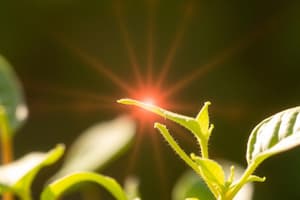Podcast
Questions and Answers
What does CAM stand for in relation to plant metabolism?
What does CAM stand for in relation to plant metabolism?
- Crassulacean Acid Metabolism (correct)
- Carbon Assimilation Mechanism
- Calvin Acid Model
- Carboxylic Acid Metabolism
Which type of photosynthesis allows plants to conserve water during high temperature and low water availability?
Which type of photosynthesis allows plants to conserve water during high temperature and low water availability?
- C3 Photosynthesis
- C4 Photosynthesis
- Calvin Cycle Photosynthesis
- CAM Photosynthesis (correct)
What distinguishes C4 plants from both C3 and CAM plants?
What distinguishes C4 plants from both C3 and CAM plants?
- They can photosynthesize faster in extreme heat. (correct)
- They only utilize carbon fixation at night.
- They can store acid during the day.
- They require less light for photosynthesis.
In what conditions do CAM plants typically take in carbon dioxide?
In what conditions do CAM plants typically take in carbon dioxide?
Which enzyme is primarily responsible for the photorespiration process?
Which enzyme is primarily responsible for the photorespiration process?
Which of the following plants exclusively utilizes C3 photosynthesis?
Which of the following plants exclusively utilizes C3 photosynthesis?
What is a main advantage of CAM metabolism for plants in arid environments?
What is a main advantage of CAM metabolism for plants in arid environments?
What role does the stored organic acid from carbon dioxide play in CAM plants during the day?
What role does the stored organic acid from carbon dioxide play in CAM plants during the day?
Flashcards
CAM photosynthesis
CAM photosynthesis
A type of photosynthesis that reduces water loss by taking in CO2 at night and using it during the day.
C4 photosynthesis
C4 photosynthesis
A type of photosynthesis that is more efficient than C3 in conserving water during high temperatures.
C3 photosynthesis
C3 photosynthesis
Standard type of photosynthesis used by many plants; less efficient than C4 or CAM in arid conditions.
Water conservation
Water conservation
Signup and view all the flashcards
Photorespiration
Photorespiration
Signup and view all the flashcards
Stomata
Stomata
Signup and view all the flashcards
Organic acid
Organic acid
Signup and view all the flashcards
Desert Plants
Desert Plants
Signup and view all the flashcards
Study Notes
Photosynthesis Types
- Three primary types of photosynthesis exist: C3, C4, and CAM.
- C3 is common under normal conditions.
- C4 is adapted to high temperature, high water, and high light.
- CAM (Crassulacean Acid Metabolism) is adapted to high temperatures but low water availability.
CAM Photosynthesis (Crassulacean Acid Metabolism)
- Involves storing CO2 at night.
- During the day, stored CO2 is converted into sugars through photosynthesis.
- CAM plants include succulents (like cacti, agaves, and succulents).
C4 Photosynthesis
- More efficient in conserving water than C3 because it reduces photorespiration.
- This is achieved through specialized biochemical pathways.
- C4 plants can photosynthesize faster in extreme heat conditions than C3 plants.
C3 Photosynthesis
- Found in the majority of plants.
- Best suited for cool, moist conditions with normal light.
- Stomata are typically open during the day.
Adaptation in Arid Environments
- C4 and CAM plants are adaptations to arid conditions.
- CAM plants are able to conserve water by closing stomata during the day and opening them at night.
- This process allows for efficient CO2 intake during the cooler, more humid hours.
CAM Plant Operation
- CO2 is absorbed at night, stored as an organic acid.
- During the day, the stored organic acid is broken down to release CO2 for sugar production.
- Stomata remain closed during the day to reduce water loss.
Photorespiration
- Photorespiration occurs when the enzyme rubisco grabs oxygen instead of CO2, blocking photosynthesis.
- C4 plants use special pathways to minimize photorespiration.
- This allows them to perform photosynthesis better in high-temperature environments.
Water Conservation in CAM Plants
- CAM plants can maintain their stomata closed, even day and night.
- This method is significantly more effective (up to 6–10 times) at preventing water loss than normal respiration.
- This works best with a significant temperature difference between day and night.
CAM Plant Idling
- CAM plants can "idle" during harsh conditions to reduce water and energy use.
- This allows survival during dry periods and faster recovery when water becomes available.
- Unlike many plants that drop leaves or become dormant during droughts.
Studying That Suits You
Use AI to generate personalized quizzes and flashcards to suit your learning preferences.




